Cyprus Police
The Cyprus Police (Greek: Αστυνομία Κύπρου), is the only National Police Service of the Republic of Cyprus and is under the Ministry of Justice and Public Order since 1993.[10]
| Cyprus Police Astinomia Kiprou Αστυνομία Κύπρου | |
|---|---|
 Cyprus Police Logo | |
| Motto | Ανθρώπινη και Υπερήφανη Humane and Proud |
| Agency overview | |
| Formed | 1960 |
| Jurisdictional structure | |
| National agency | CY |
| Operations jurisdiction | CY |
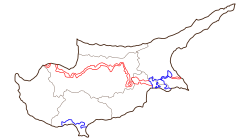 | |
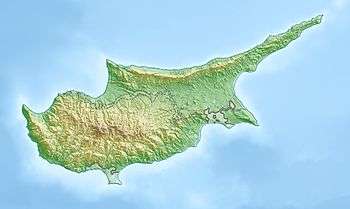 | |
| Above: Northern part of the island currently not policed by the Republic of Cyprus as it is under the de facto control of Northern Cyprus. Outlined in red is the UN buffer zone and outlined in blue are the areas of the British Sovereign Bases. Below: Relief map of Cyprus showing mountains and sea. Red dot indicating capital and Headquarters location. | |
| Size | 9,251 km² total Areas Cyprus Police does not operate in 3,355 km² occupied area (North) 346km² UN buffer zone 254km² British Sovereign Bases[1] |
| Population | 838,897[2] |
| Primary governing body | Republic of Cyprus |
| Secondary governing body | Ministry of Justice and Public Order (Cyprus) |
| Constituting instruments | |
| General nature | |
| Operational structure | |
| Overviewed by Government Agency | Independent Authority for the Investigation of Allegations and Complaints against the Police[4] |
| Headquarters | Antistratigou Evaggelou Floraki Str., Aglantzia, Nicosia, Cyprus |
| Police Officers | 4927 |
| Specialized posts | 92 (data taken on 31/01/2012) |
| Minister responsible |
|
| Agency executive |
|
| Facilities | |
| Police Stations | 50[7] excluding substations, offices, units etc. |
| Airbases | 1[8] |
| Boats | 5 Fast Sea Patrol Boats 5 Patrol Boats 6 Rigit Inflatable Boats[9] |
| Helicopters | 2 Bell 412EP 2 AgustaWestland AW139[8] |
| Website | |
| http://www.police.gov.cy/ | |
| Emergency Telephone Number 112 or 199 Citizen's Line 1460 Narcotics Line 1498 Hunter’s Line 1414 Fire report line 1407 Rescue Coordination Center 1441 | |
The duties and responsibilities of the Cyprus Police are set out in the amended Police Law (N.73(1)) of 2004 and include the maintenance of Law and Order, the prevention and detection of crime as well as arresting and bringing offenders to justice.[11]
History
Although the history of Law enforcement in Cyprus goes back to 1879 when the first Police Law was passed by the then British Colonial Government, which operated a mounted gendarmerie force known as the Cyprus Military Police, the history of the Cyprus Police begins with the establishment of the Republic of Cyprus in 1960.
In 1960 two Public Security Forces were established within the framework of the Constitution: the Police Force, which was responsible for policing the urban areas, and the Gendarmerie, which was responsible for policing rural areas. A Greek-Cypriot Chief and a Turkish-Cypriot Chief administered the two Forces respectively.[12]
The two forces of the Police were joined to form the present police service during the year 1964, shortly after the intercommunal troubles between the Greek and the Turkish communities, as a result of which the Turkish Cypriot officers abandoned their posts.[10] Additionally the conflict created great problems for the Police, who had to handle the situation, along with the then sparsely manned Cypriot Army, because it was the only organized force.
With the creation of the Cypriot National Guard in 1964, the duties of military nature were transferred to the National Guard and the Police was limited back to its usual duties.[13]
Also notable is that a museum dedicated to the history of the Cyprus Police and Law enforcement in Cyprus in general exists, with a history of its own. The Cyprus Police Museum, owned by the Cyprus Police and managed by the Department A' of the Police Headquarters is open to the general public.
Authorities
The Cyprus Police operates and exercises its authorities throughout the territory of the Republic of Cyprus based on the following Laws and Regulations:
- The Constitution of the Republic of Cyprus
- Police Law (N.73(I)/2004)[14]
- Police Regulations
- Police Standing Orders
- Criminal Code Cap.154
- Criminal Procedure Law Cap.155
- Evidence Law Cap-9
- The Processing of Personal Data (Protection of the Individual) Law 138(1)/2001
The legal framework within which the Cyprus Police exists and operates is determined by the Constitution, Police Law Cap.285 and other laws that provide the authority for investigation, detention, arrest, questioning and prosecution of offenders of the Law.
Structure and organisation
The structure and organisation of the Cyprus Police is governed by Police Ordinance 1/10 and is formed as stated below:[15]
Headquarters
The Police Headquarters is divided into different Departments/Directorates/Services and Units, each specializing in a different field/aspect of policing.
Departments
- Department A' (Administration)
- Department B' (Traffic, Transport)
- Department C' (Criminal Investigations, Prosecutors)
- Department D' (Scientific & Technical Support)
- Research and Development Department
Directorates
- European Union & International Police Cooperation Directorate
- Materials & Supplies Management Directorate
- Airports Security Directorate
- Finance Directorate
- Directorate of Professional Standards
Services
- Aliens & Immigration Service
- Drug Law Enforcement Service
- Forensic Investigations Service
- Audit & Inspection Service
- Central Intelligence Service
Units
- Cyprus Police Academy
- Emergency Response Unit
- Presidential Guard Unit
- Port & Marine Police
- Cyprus Police Aviation Unit (Previously named Police Air Wing)
Divisions
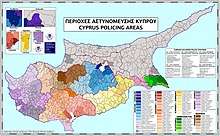
The Cyprus Police has one Division for each district of Cyprus. Under this divisions are the Police Stations but also within each Police Division, branches can be created similar to the branches of the Police Headquarters. For example, there is a Headquarters Drug Law Enforcement Service but also a Nicosia, Limassol etc. Drug Law Enforcement Service. Other examples include Headquarters Criminal Investigation Department (C.I.D.)- Larnaca, Nicosia, Limassol etc. C.I.D. and Headquarters Traffic Department - Nicosia, Limassol etc. Traffic Department . The difference is that the Headquarters units/services etc. operate throughout the territory of the Cyprus Republic while the divisional (provincial) units/services operate mostly within the District that are located.[16]
Because the Cyprus Fire Service is part of the Police in Cyprus, it is listed as a division of the Police with nationwide jurisdiction.[17]
- Nicosia
- Limassol
- Larnaca
- Famagusta
- Paphos
- Keryneia
- Morphou
- Fire Service - The Fire Service operates as an independent Division based in Nicosia but with national coverage.
Because of the Turkish invasion and continuing occupation, the Police Divisional Headquarters of Famagusta and Morphou are temporarily housed in Paralimni and Evrychou respectively, while the Kyrenia Police Division has temporarily suspended its operation.[17]
Personnel
Ranks and insignia
Below is a table showing the Cyprus police ranks in hierarchical order along with their identification markings and insignia.[18]
| Title in Greek | Title | Epaulette | Epaulette image | Sleeve | Sleeve image | Shirt colour | Group |
|---|---|---|---|---|---|---|---|
| Αρχηγός | Chief of Police | batons in Laurel wreath a star and the Cyprus Coat of arms |
Light Blue | Ηighest Αdministrative Αuthority (Senior Officers) | |||
| Υπαρχηγός | Deputy Chief of Police | batons in Laurel wreath and a star |
|||||
| Βοηθός Αρχηγός | Assistant Chief of Police | batons in Laurel wreath |
|||||
| Ανώτερος Αστυνόμος | Chief Superintendent | Cyprus Coat of arms |
Senior Officers | ||||
| Αστυνόμος Α' | Superintendent A' | Cyprus Coat of arms |
|||||
| Αστυνόμος Β' | Superintendent B' | ||||||
| Ανώτερος Υπαστυνόμος | Chief Inspector | Officers | |||||
| Υπαστυνόμος | Inspector | ||||||
| Αρχιλοχίας | Senior Sergeant | Police emblem on top |
Light Blue | ||||
| Λοχίας | Sergeant | ||||||
| Αναπληρωτής Λοχίας Αρχιαστυφύλακας |
Acting Sergeant Senior Constable |
Police emblem on top |
|||||
| Αναπληρωτής Λοχίας | Acting Sergeant | ||||||
| Αρχιαστυφύλακας | Senior Constable | Police emblem on top |
|||||
| Αστυφύλακας | Constable | ||||||
| Ειδικός Αστυφύλακας | Special Constable | a yellow line on each side along the epaulette |
Special Constable
Special Constables are recruited separately from regular Constables and in accordance with Article 39 of the Police Law (N.73 (I) / 2004) they are recruited for clerical and auxiliary duties, guard duties of publicly owned buildings and facilities, VIPs and foreign missions protection and for the delivery and execution of court orders and / or any other orders.[14]
Article 41 of the Police Law (N.73 (I) / 2004) states that any Special Constable appointed under this Act, shall perform the duties assigned to him and, in the exercise of his duties, has same powers, the same privileges, the same protection and is subject to the same penalties and to the same principles as regular Constables.[14]
Special Constables are usually referred to as "Special", even in Greek, and rarely as "Ειδικοί" (usually in more formal references) which is short for the Greek title "Ειδικός Αστυφύλακας". The curriculum of Special Constables at the Police Academy is less than the curriculum of regular Constables and also shorter in duration. The pay grade that the Special Constables enter the Police is lower in relation to the pay grade that the regular Constables enter.
A Special Constable cannot be "promoted to a regular Constable". Instead Special Constables wishing to enter the Cyprus Police as regular Constables have to go through the same recruitment process as anyone else, including any written or physical condition exams, irrelevant of the years that they have been already working in the Cyprus Police and irrelevant of the fact that they might be transferred after completion of their training as regular Constables back to the position they were serving as Special Constables. An exception on the age of entry was made for Special Constables that were already serving in the Police before the enforcement of Police Law of 2004. The enrolment age restrictions for regular Constables, applies to Special Constables wishing to enroll as regular Constables if they were recruited after the date that the Police Law of 2004 was enforced.[14]
Constable
Constable is the entry rank in the Cyprus Police. This rank represents the largest percentage of Police Officers serving in the Cyprus Police. All Police Officers begin their careers at this rank (with the exception of the specialized personnel that enter the Police under a different agreement).
Senior Constable
A Senior Constable is not considered a promotion. Senior Constables are Constables assigned duties higher to their rank level, they are called Senior Constables and bear the distinctive insignia. To become a Senior Constable a Constable must meet the following requirements:[19]
- They have completed 12 years of service and have passed the examination for promotion to the rank of Sergeant
- During the last two years they have not been imposed with a penalty greater than "severe reprimand" for a disciplinary offence and
- they have been recommended by the officer in charge of their Unit as suitable and well trained in police duties
Acting Sergeant / Acting Sergeant Senior Constable
Under Regulation 213/2004, the Chief of Police may, at any time he considers that the needs of the service so require for a short period of time, to select any Constable who is qualified for promotion to Sergeant and assign him to Sergeant duties for a period not exceeding three months but in no event exceeding for the same person a total of two years. Such a person is called Acting Sergeant. After this time period ends, this person reverts to the rank of Constable or Senior Constable respectively, depending on what he was before his assignment as Acting Sergeant. Before the implementation of Regulation 213/2004 this appointment was permanent and not temporary.[20] In 2019 the Rank and Rank Insignia of Acting Sergeant Senior Constable was abolished.
Sergeant
Sergeant is the first rank a Constable is promoted to. Usually sergeants are in charge of a specific shift at a Police Station, a squad or a small team.
Senior Sergeant
A Senior Sergeant is not considered a promotion. Senior Sergeants are Sergeants assigned duties higher to their rank level, they are called Senior Sergeants and bear the distinctive insignia. To become a Senior Sergeant a Sergeant must meet the following requirements:[19]
- They have completed 8 years of service at the rank of Sergeant and have passed the examination for promotion to the rank of Inspector
- During the last two years they have not been imposed with a penalty greater than "severe reprimand" for a disciplinary offence and
- they have been recommended by the officer in charge of their Unit as suitable and well trained in police duties
Education and training
All police constables (PCs) have to attend a three-year course at the Cyprus Police Academy, which is recognized as a higher education institution.[21] The course alternates between theory at the Police Academy and practical training in the field. Special police constables (SPCs) also attend the police academy for a seventeen-week course. All PCs and SPCs, as part of their training attend the Special Training Center of the Emergency Response Unit for firearms training and other physical forms of training.[22]
The highly variable field of law enforcement demands and highly promotes continuing education. For this reason police officers of all ranks continue attending courses throughout their careers. Such courses are conducted by the Cyprus Police Academy[22] or by foreign training agencies such as the FBI National Academy and the National Security School of the Greek Police Academy. The duration of these courses is from a couple of days, up to several months or in some cases more than a year. To assist cross-border common training, exist the Cyprus Police is a member of many international programs and agencies, for example CEPOL.
Equipment
Vehicles
Markings
Cyprus Police cars are white with a blue stripe that goes around the car. On both sides they have printed on them the words POLICE and ΑΣΤΥΝΟΜΙΑ, which means Police in Greek. They also have the logo of the Cyprus Police, usually on the front doors and also have printed on them the Police’s website www.police.gov.cy. An exception to this is some of the cars used by the Neighbourhood Police that have the Neighbourhood Police logo instead of the Cyprus Police Logo. On the front part of the car they have again the logo with the words POLICE and ΑΣΤΥΝΟΜΙΑ and at the back they could have, depending on the model of the car and the space available, the words Police in Greek and English or just the Cyprus Police insignia or both. On the roof they have printed a distinct number for each one as aerial roof markings.
In 2011 a trial version for new markings was used on an old Opel Vectra patrol car. These were half-Battenburg markings with a highly reflective blue-yellow stripe on the sides instead of the solid blue stripe. Additionally the back was covered in reflective yellow-red diagonal stripes and had printed the emergency phone number 112. The front part on the hood of the car had the words ΑΣΤΥΝΟΜΙΑ and POLICE printed inverted so that they would appear correctly when seen through a mirror. These markings were not enforced.
In 2012 new markings were enforced were the blue stripe although still solid was replaced with a highly reflective one, and the rear horizontal line was replaced from a solid blue stripe to a blue-white diagonal line similar to the rear usually found on vehicles with Battenburg markings.
The Cyprus Police also uses unmarked vehicles. Unmarked vehicles are not necessarily covert to be used for undercover work. Most unmarked cars are the same models as the patrol cars and they are mostly used by plain clothed officers such as crime investigators, crime prevention squads, technicians etc. Most of these cars are fitted with sirens and can be seen in the streets with detachable strobe lights.
Lists of vehicles
| Year entered service* |
Vehicle | Photo | Manufacturer | Production Model |
Engine | Purpose | Notes |
|---|---|---|---|---|---|---|---|
| Toyota Landcruiser | Multi-purpose car | ||||||
| Opel Vectra |  | Multi-purpose car | |||||
| Peugeot 406 | Multi-purpose car | ||||||
| Renault Laguna | Multi-purpose car | ||||||
| Renault Megane |  | Multi-purpose car | |||||
| Prinoth Husky | Snow Trac | ||||||
| Honda CR-V | Multi-purpose car | ||||||
| Isuzu Trooper |  | Multi-purpose car | |||||
| Mazda3 | 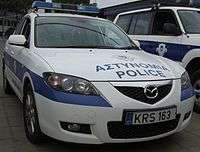 | Multi-purpose car | |||||
| Peugeot Boxer | Support | ||||||
| Ford Transit | 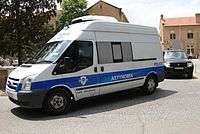 | Support | |||||
| Renault Trafic | 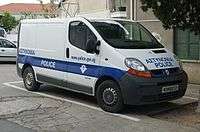 | Support | |||||
| Renault Master | Support | ||||||
| Nissan Pathfinder | Multi-purpose car | ||||||
| Mitsubishi Pajero | Multi-purpose car | ||||||
| Kia Magentis | 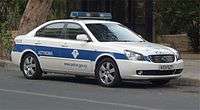 | Multi-purpose car | |||||
| Chevrolet Matiz | Neighbourhood Police | ||||||
| Kia Rio | Multi-purpose car | ||||||
| Isuzu D-Max | Support | ||||||
| Ford Focus | Multi-purpose car | ||||||
| Ford Mondeo | Multi-purpose car | ||||||
| Ford Mondeo | Multi-purpose car |
*Unless specifically referenced, the dates the vehicles entered service are based on their license plate registration numbers
| Year entered service* |
Motorcycle | Photo | Manufacturer | Production Model |
Engine | Purpose | Notes |
|---|---|---|---|---|---|---|---|
| Honda CBX750 | Traffic/Response vehicle | ||||||
| Suzuki GSX 750P | Traffic/Response vehicle | ||||||
| Honda Pan-European | Traffic/Response vehicle | ||||||
| Suzuki GSX-R1000 | Traffic/Response vehicle | ||||||
| Suzuki V-Strom 1000 | Traffic/Response vehicle | ||||||
| KTM 640 Adventure | Traffic/Response vehicle | ||||||
| BMW C1 | Neighbourhood Police | ||||||
| Honda CBR1000RR | Traffic/Response vehicle | ||||||
| Honda Varadero | Traffic/Response vehicle |
*Unless specifically referenced, the dates the vehicles entered service are based on their license plate registration numbers
Aerial vehicles
Boats
Firearms
All police officers in the Cyprus Police are trained in the use of both pistols and Submachine guns as part of their basic training.[22] Although there is an array of different firearms and ammunition types in use in the Cyprus Police, ranging from Shotguns to Machine guns, the most commonly used firearms are the Heckler & Koch USP and the Heckler & Koch MP5.
| Year entered service |
Name | Photo | Manufacturer | Caliber | Type | Notes |
|---|---|---|---|---|---|---|
| Smith & Wesson Model 60 | Revolver | No longer used | ||||
| Browning Hi-Power | Semi-automatic pistol | Limited Use | ||||
| CZ Model 75 | Semi-automatic pistol | No longer used | ||||
| Heckler & Koch USP | Semi-automatic pistol | Commonly Used | ||||
| SIG Sauer P226 | 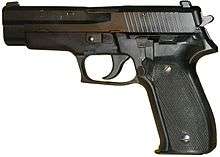 | Semi-automatic pistol | Limited Use | |||
| Glock | Semi-automatic pistol | Limited Use | ||||
| Heckler & Koch MP5 |  | Submachine gun | Commonly Used | |||
| vz. 58 | Assault rifle | No longer used | ||||
| AK-47 | 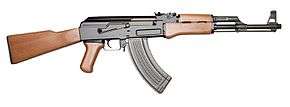 | Assault rifle | Limited Use |
The firearm photos in the table are not to scale
Gallery
- Cyprus Police Aviation Unit Bell 412EP participating in fire fighting efforts in Israel, during the 2010 Mount Carmel forest fire
 Cyprus Police Aviation Unit Bell 412EP
Cyprus Police Aviation Unit Bell 412EP- Cyprus Port and Marine Police jet F.P.B. (Fast sea Patrol Boat)
- Cyprus Port and Marine Police R.I.B. (Rigid Inflatable Boat)
See also
| Wikimedia Commons has media related to Police of Cyprus. |
- Cyprus Civil Defence
- Cyprus Fire Service
- Cyprus Joint Rescue Coordination Center
- Cyprus Police Academy
- Cyprus Police Aviation Unit
- Cyprus Police Museum
- Cyprus Port & Marine Police
- Cyprus Prisons Department
- Hellenic Police
- Sovereign Base Areas Customs
- Sovereign Base Areas Police
- Cyprus Joint Police Unit
References
- List of countries and outlying territories by total area#cite note-60
- Cyprus Republic Statistical Service "Announcements". 23 December 2011. Retrieved 31 Jan 2012.
- IAIACAP Official Website "Welcome Page". Retrieved 31 Jan 2012.
- Ministry of Justice and Public Order "Minister's CV". Retrieved 8 Jul 2013.
- Cyprus Police Official Website "Chief of Police CV". Archived from the original on 8 February 2012. Retrieved 31 Jan 2012.
- Cyprus Police Official Website "Useful Telephones". Retrieved 31 Jan 2012.
- Cyprus Police Official Website "Cyprus Police Aviation Unit". Retrieved 31 Jan 2012.
- Cyprus Police Official Website "Police Border Marine". Retrieved 31 Jan 2012.
- "Defence - Security - Police". Cyprus Government Web Portal. Retrieved 11 October 2012.
- Cyprus Police Official Website"Mission". Retrieved 26 July 2012.
- Cyprus Police Official Website"Historical Background". Archived from the original on 8 October 2012. Retrieved 11 October 2012.
- Κυβερνητική Πύλη ΔιαδικτύουΆμυνα - Ασφάλεια - Αστυνομία (in Greek). Retrieved 12 October 2012.
- Police Law (N.73(I)/2004)Ο Περί Αστυνομίας Νόμος του 2004 (73(I)/2004) (in Greek), 2004
- Police Ordinance 1/10 Οργάνωση της Αστυνομίας και Καθήκοντα των Μελών της (in Greek), Cyprus Police, 6 April 2012, p. 21
- Cyprus Police Official Website "Nicosia Police Division". Retrieved 31 Jan 2012.
- Cyprus Police Official Website "Composition". Retrieved 31 Jan 2012.
- "Police Rank Insignia". Archived from the original on 30 March 2012. Retrieved 26 July 2012.
- Regulation 51/1989 - Κανονιστική Διοικητική Πράξη 51/1989
- Regulation 213/2004 - Κανονιστική Διοικητική Πράξη 213/2004
- KY.S.A.T.S. Website ΚΥΠΡΟΣ (Αναγνωρισμένα Ιδρύματα) (in Greek). Retrieved 8 October 2012.
- Cyprus Police"Οδηγός Σπουδών" (Press release). Αστυνομική Ακαδημία Κύπρου. 2009. p. 40. Archived from the original on 13 February 2012. Retrieved 27 July 2012.
- Politis Sports"H CHEVROLET ΣΥΜΒΑΛΛΕΙ ΣΤΟ ΘΕΣΜΟ Matiz, "Αστυνομικός της Γειτονιάς!"". Politis. 21 January 2009. Archived from the original on 1 March 2014. Retrieved 12 Sep 2012.

